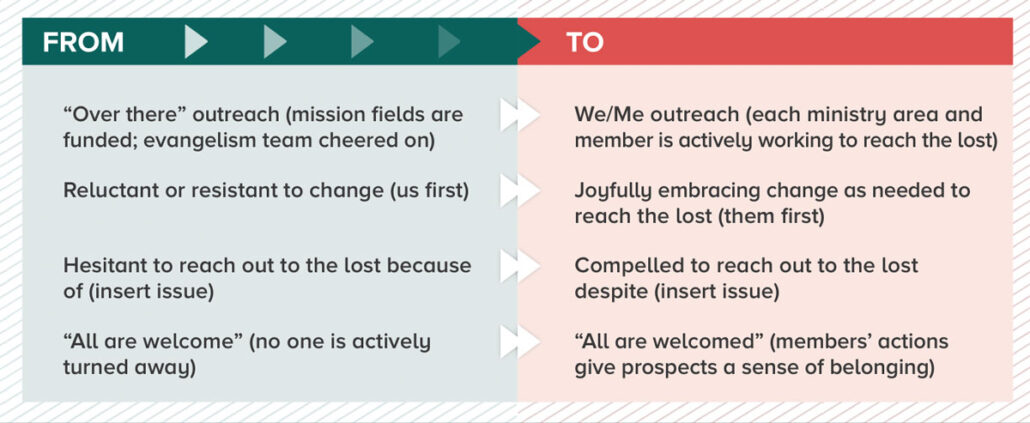 |
Congregational culture change isn’t easy, but if successful, it opens up new ways of using the gifts God has given us to further his kingdom.
Story at a glance
- An organization’s culture is the shared thought habits that frame the way people behave and work together.
- A congregation benefits by reflecting on its culture to see if it presents barriers to ministry.
- Writing a clear FROM/TO statement—identifying the old way of thinking and what you wish to shift to—can help members see and agree on the desired shift.
Is there a business that keeps drawing you back not because of its price or selection but because of some other trait? Perhaps it is your neighborhood coffee shop—the one where everyone is so friendly and somehow feels like a little piece of your hometown, even though you’ve moved hundreds of miles away. Or maybe it is that small hardware store—the one where it feels okay to ask any question, where you don’t feel judged by what you don’t know or have failed to do. Or it could be an airline, the one where folks seem genuinely happy to help instead of just following the rules.
Cultural DNA
If some recurring attribute keeps drawing you back to a business, odds are that it is an element of that organization’s culture. If you asked employees about it, it wouldn’t be surprising if they said something like “That’s who we are” or “It’s just in our DNA!” Note it to a small-business owner and he may reply, “Thank you; we’ve worked hard to become so!” That attractive, repeated pattern keeps showing up because people in the business share common thought habits—perhaps even intentionally built-up ones.
How about your congregation? What are some recurring patterns of behavior that keep showing up without people even thinking about it because it’s just who you are? One way to view an organization’s culture is as the shared thought habits that frame the way people behave and work together. Those shared thought habits are powerful. They act like a frame around a picture—as a border of who you are and what you do or don’t do, say or don’t say.
Those shared thought habits also act as a structural frame—supporting programs and activities. Like the studs in a house’s walls, your congregation may not see those thought habits, but they’re there. And if there are structural problems in your culture, your congregation will see issues, even if the cause may not be obvious.
If we view an organization’s culture as the shared thought habits that frame how people behave and work together, it really highlights the power of culture change. It is not just eliminating how we can trip ourselves up. A new way of thinking leads to a new way of acting and new possibilities. Shifting shared thought habits means we’re in sync about how we want to move forward and how to work toward those possibilities.
Not that there won’t be challenges. Habits can be tough to change—shared thought habits even more so. Underlying thought habits that can cause us to get in our own way can be hidden to us because they aren’t necessarily a conscious choice—they can simply be us on autopilot, a subconscious response.
Start with reflection
If you are thinking about addressing your congregation’s culture, the first challenge is seeing the issues.
A good place to start is simply to reflect on how things get done in your congregation—points both positive and negative. Patterns of “how things get done here” can be visible consequences of the congregation’s culture. To help see both positive and less-than-helpful aspects of the patterns, involve a larger group and make sure you consider multiple perspectives such as long-time members, new members, and first-time visitors. Once patterns are seen in behaviors, you’ll need to “pull the thread,” to unravel and explore the thinking behind the behaviors; this is where you’ll identify the shared thinking that constitutes culture (see “Pulling the thread” below). You can start by simply asking “Why do you suppose we do that?” or “What’s the thinking behind that?”
Ironically, depending on your current culture, this reflection may be hard or uncomfortable; it could be viewed as criticism or rocking the boat. Approaching the conversation with curiosity—“I see this; what do you see?”—and assuming positive intent can help mitigate this.
Help everyone see the issue
If you want to address an identified culture issue—a specific way of thinking about things that members of the congregation have in common and seems to be getting in the way of your ministry—you need to have a critical mass of members seeing it and working to shift to a new way of thinking. Culture change is definitely a team sport!
Communicating with a clear FROM/TO statement—identifying the old way of thinking or being and what you wish to shift to—can help align the effort (see example below).

Try something different
Once there is consensus, it is time to begin acting in line with who you want to be when the culture shift is complete. Just as repetitions of weight lifts are used to build muscle, getting in “mental reps” is key to strengthening the new way of thinking and making it into a habit.
One way to promote these mental reps is with a trigger that reminds people to think and act differently in a situation. I’ve heard that one congregation that struggled with intermingling with visitors implemented what it called “the 5-minute rule”: For the first five minutes after worship, members focus on speaking with people they don’t know or don’t know that well. The pastor literally said, “The 5-minute rule is in effect,” right before people left worship. This simple-to-under-stand reminder gave members a nudge at just the right place and time when they wanted to think and act differently. What a powerful way to trigger mental reps!
The impact of a culture shift
The power of a group to shift its thinking—when the change is clearly identified and everyone is working actively to enact it—is remarkable. A factory that I worked at in northern Italy was once challenged by visiting US-based executives to own fully the need to improve despite the challenges confronting it. They noted that multiple times people had offered the expression “Non é possible”—literally “It is not possible”—as to why something wasn’t pursued.
Afterward we agreed that a thought habit of making excuses existed in our plant and decided to eradicate it. We kicked off our effort by outlawing the phrase “Non é possible.”
Whenever we heard someone use that phrase, we were to interrupt that person immediately mid sentence!—and point out the outlawed expression. Then we were to shift to a discussion of why it might be difficult and determine how we could get past the obstacle(s). Some people were amazed at how often they said that phrase; within days you could see the gun-shy look on their face as they carefully chose their words. Within a few weeks, they were thinking differently and, therefore, acting differently.
Congregational culture change isn’t easy, but if successful, it always—by definition—opens up new ways of thinking and using the gifts God has given us, individually and collectively, to further his kingdom. Identifying ways to better use our time, talents, and treasures to glorify God and proclaim his message of salvation makes culture change worth the effort.
View Eric Roecker and Kurt Nitz’s presentation from the WELS National Conference on Lutheran Leadership at lutheranleadership.com.
Pulling the thread
My wife was in a group doing a self-assessment of our congregation when they came to the question “Are we friendly?” The group gave a resounding “Yes!” to the question and was ready to move on when my wife offered an unexpected observation: “It is true that there are many deep friendships here; but when someone first comes to worship, the initial impression can be that people here are not particularly friendly.”
The thought habit of genuine love and caring for brothers and sisters in Christ showed up in joyful Sunday morning discussions. It also showed up in not taking time to speak with new visitors. It was probably easier for my wife to see that because we had been members of seven different congregations in the previous 21 years and had recently joined that congregation.
Fully pulling the thread means not just seeing the positive aspects of a thought habit (we love to spend time with our friends at church) but also the less-than-helpful ones (like a tendency to not notice or speak with fresh faces).
Author: Kurt Nitz
Volume 110, Number 12
Issue: December 2023
- Challenged churches
- Jesus’ church will not be overcome
- Refined by fire
- The importance of followers
- Our Lutheran moment
- Leading from your knees
- Leadership conference equips members to serve
- Training the next generation of leaders
- Moving the needle
- Strengthening ministry teams
- Reflections on Lutheran leadership
- Lutheran leadership: Not just authority
- Shifting congregational culture
- Partners in ministry
- The love of Christ compels us
- The Lord’s triple gift







